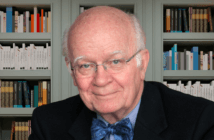Lovett H. Weems Jr. says incoming pastors tend to see everything through the lens of their own experience, vision, and interests, rather than learning how things got to be the way they are. Good leadership is always about the group, not the leader, says Weems. So it’s important for new pastors to take time to understand the pulse of a new congregation.
When clergy enter a new pastoral setting, it is difficult to avoid comparing everything in the new place with what they have done in the past or to a general understanding of what is good for any church. New pastors tend to see everything through the lens of their own experiences, which may or may not fit the new context. Despite their best intentions, they often see deficiencies of past leadership much more quickly than strengths. Writing in his journal in 1924 as a young pastor in Detroit, Reinhold Niebuhr observed, “One of the most disillusioning experiences which I have had with ministers is their invariable tendency to belittle or to be unappreciative of the work of their predecessors.”
The consequences of ignoring context
Three examples illustrate what can happen if context is not considered before making major changes.
- A church had developed a strong tradition of recognizing on All Saints Sunday members who had died in the past year. While naming and ringing a bell for each of the deceased took a brief portion of the service, the care with which it was planned and promoted made All Saints Sunday one of the best attended Sundays of the year. It also became an occasion for people to learn about the history and meaning of a Christian tradition new to many of them. An entering pastor moved this recognition from All Saints to Memorial Day Sunday without adequately inquiring about the local tradition. The Memorial Day recognition never caught on in this church so schooled in the All Saints tradition.
- In another case, a church had for years held youth confirmation on Easter, certainly an appropriate time. But there was always a time crunch, and, with extra attendance, families of confirmands were not always able to sit together. So the congregation shifted the reception of confirmation class members to Pentecost Sunday, also a meaningful time for such an important event. But a new pastor, who had always received confirmation classes into membership on Easter, changed confirmation back to Easter. This pastor, who had previously served in smaller churches, failed to understand the challenges of Easter confirmation experienced by the new church and without appropriate consultation made a poor decision.
- The third example occurred when a pastor very interested in mission went to a church with a long history of mission engagement. That match was good. However, the new pastor failed to recognize the strong ties between the church and a particular place where youth mission teams had served for the past 20 years. The incoming pastor had similar long connections with another place equally in need of help and, by the pastor’s second year, had changed the mission trip location with little consultation.
Begin with the people you are called to serve
How can an entering pastor avoid such mistakes? One example of taking the time and having the interest to appreciate a new context involves a pastor whose personal passion had always centered on teaching and education. In every church he served, he would establish high quality studies that offered wonderful opportunities to learn more about the Bible, history, theology, and ethics. After serving many years at a church where the interest in Christian education matched his, this pastor went to another church whose identity revolved around mission. From the first day, every person the new pastor met talked about the congregation’s vast engagement in a multitude of mission initiatives. It would have been tempting for this incoming pastor to say, “That’s wonderful” and then proceed to implement his own priorities around education and learning.
Instead, the new pastor spent the first year immersed in the congregation’s vital life of mission. He came to understand the culture of the church and to know the key leaders well. After a year, the pastor began asking some of those leaders some questions such as, “Have you ever studied biblical models of mission? Or the history of missions? Or the theology of mission?” Invariably, those active leaders were unaware that such learning was available. “Could we study that?” and “I’d love to know more” were the responses. Out of these conversations emerged a Mission Academy that gave those active in mission the opportunity each year to study in depth a new aspect of the biblical, theological, historical, or ethical dimensions of mission. It also gave the pastor a chance to exercise his vision and gifts in a way that fit the new context.
The pastor began with the people God had given rather than beginning with the pastor’s interests. This is a good reminder of something we know about leadership but often forget — leadership is always about a group, not the leader. Leadership begins with those whom God has given us the opportunity to serve.







